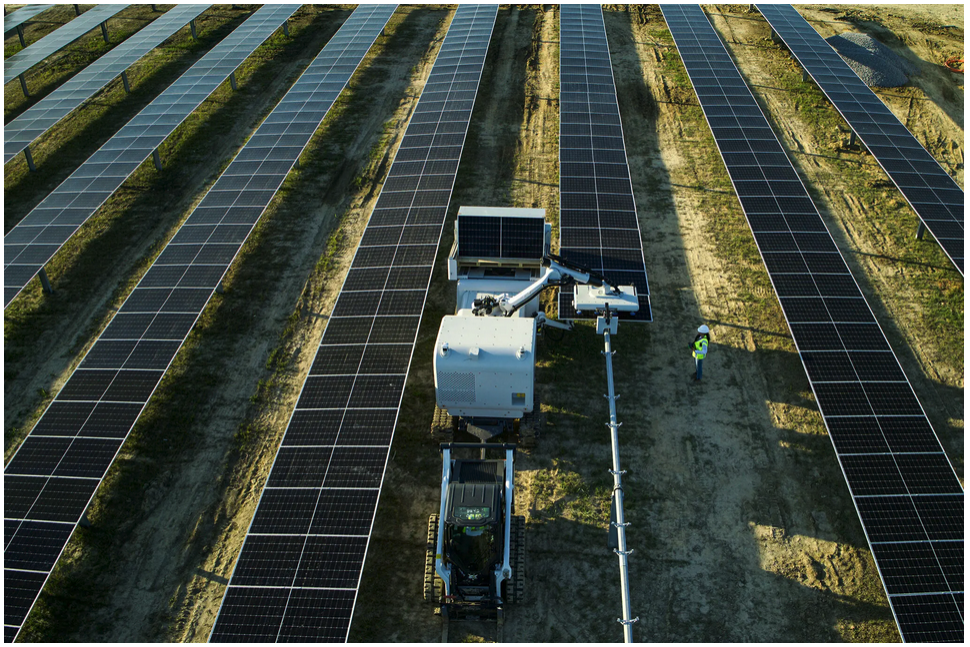|
|
 |
|
|
|
Good morning and happy Friday,
This week, a bipartisan group of U.S. Senators introduced legislation to block Chinese solar and clean energy companies from receiving taxpayer dollars, including funds from the IRA, and the Office of the U.S. Trade Representative delayed a new decision on Section 301 tariffs.
Meanwhile, their colleague Sen. Joe Manchin “exuded joy” after his permitting reform bill passed out of the Senate Energy and Natural Resources Committee – although some allies of the environmental community voted against the bill, which many climate activists say “lock(s) in generations of fossil fuel production and exports.”
In any case, “steep obstacles remain” for the legislation to become law in “a wildly unpredictable election year.”
And, Democrats across the country are on tenterhooks as they await presumptive presidential nominee Kamala Harris’ announcement of her VP pick. Among the many vying for this honor, Sen. Mark Kelly would bring chops on water and mining, whereas PA Governor Josh Shapiro could allay concerns that she’ll ban fracking (her campaign has pledged she won’t).
Read on for more.
|
|
|
 |
|
|
Hay There!
Agrivoltaics is a hot topic these days, and two recent articles explore the subject in detail. One outlines a large-scale research project in Ohio that’s exploring how solar and farming can co-exist; the other looks at how some farmers and solar developers are working side-by-side in Illinois. Here’s what’s cropped up:
-
The Ohio research seeks to “shed light on how well multi-use farming can work at a large scale,” providing answers that will address concerns about siting large solar projects on farmland, while also helping shape best practices.
-
Grazing sheep amidst solar panels is one option, but research in both states is also exploring which crops fare well when paired with solar. Corn “needs lots of sun and grows high” so it isn’t a good choice, but hay, alfalfa and soybeans could work. Other issues include compatibility with farm machinery and precision agriculture.
- Illinois has been proactive, passing a zoning law making land approved for agricultural or industrial use also eligible for solar projects, and last month’s Solar Farm Summit in Chicago convened stakeholders to discuss how solar and agriculture can be mutually beneficial.
⚡️ The Takeaway
Striking a baaa-lance. While a growing number of farmers see solar as a potential financial safety net, the American Farmland Trust estimates 83% of new solar projects developed by 2040 could be sited on farm and ranch land and warns that “although solar is projected to cover just 1% of total farmland in the US, the most productive farmland is most likely to be affected.” Although the potential impact of solar is much smaller than other threats to farmland, it’s an issue that calls for thoughtful engagement. |
|
|
 |
|
|
Reading Between the Lines
Election Day is just 97 days away, and over the past week we must have seen at least that many articles about how the outcome could impact the clean energy sector. Here are a handful of viewpoints to consider:
⚡️ The Takeaway
Whither weather? A third article from Heatmap (hey, can we get a discount on our subscription?) reminds us that the Green New Deal – or as Mr. Trump calls it, the “Green New Scam” – never actually passed, although many of its goals have been achieved. In contrast, we hope many goals of Project 2025 never come to fruition, particularly the “demolition of NOAA and the National Weather Service.” 97 more days of unsettled weather ahead!
|
|
|
 |
|
|
|
|
|
|
 |
|
|
|
|
 |
|
|
R. U. Ready?
Today’s fun etymological fact is that the word “robot” is derived from the Czech word for “forced labor;” it entered the vernacular with the premier of Rossum’s Universal Robots (“R.U.R.” for short), a 1921 play written by Karel Čapek, “a Czech writer who wrote many plays and novels, many of them with science-fiction and dystopian themes.”
On that upbeat note, we’re pleased to introduce Maximo, a robot owned by AES Corporation that specializes in installing 60+-lb. utility-scale solar panels – eventually, “twice as fast as humans can and at half the cost.”
Maximo has undergone months of testing, and AES says its (his?) first big-boy job will be building the Bellefield solar + storage project in Kern County, CA, later this year. It’s a significant development for a labor-intensive industry that is facing serious labor shortages: “By some estimates, the country will need 475,000 solar workers by 2033, nearly double today’s number. Yet 44 percent of solar companies already say it is ‘very difficult’ to find qualified workers.”
|
 |
|
|
|
AES Corporation’s Maximo robot. It can install hundreds of solar panels, often weighing 60 pounds or more, in a single day, even when temperatures rise into the 100s Fahrenheit. Credit: AES Corporation.
|
|
And while we’re on the topic of words that have dystopic origins, we wanted to also tell you about KoBold Metals, a company “named for a creature in Germanic folklore that was blamed for poisoning miners.”
Spoiler alert: the “creature” is actually cobalt, an essential part of the energy transition – and KoBold is “finding the materials of the future with AI and HI” (HI = human intelligence). As the WSJ reports, the Silicon Valley startup is using AI to scour the Earth for copper and lithium. The future is here – R.U. Ready?
|
|
|
 |
|
|
|
Contact us to learn more about working with Bantam. |
|
|
| Contact Us |
|
|
|
|
|
|
|
|
 |
|
|
|
|
|
|
Copyright © 2024 Bantam Communications, All rights reserved.
|
|
|
|
|